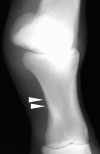Use of standing low-field magnetic resonance imaging to assess oblique distal sesamoidean ligament desmitis in three Thoroughbred racehorses
- PMID: 27320360
- PMCID: PMC5059375
- DOI: 10.1292/jvms.15-0656
Use of standing low-field magnetic resonance imaging to assess oblique distal sesamoidean ligament desmitis in three Thoroughbred racehorses
Abstract
Desmitis of the oblique distal sesamoidean ligaments (ODSL) is caused by hyperextension of the metacarpophalangeal/metatarsophalangeal joint and has been described as a significant cause of lameness in racehorses. In this study, three Thoroughbred racehorses (age range: 3-6 years) were diagnosed with desmitis of the forelimb ODSL using standing low-field magnetic resonance imaging (sMRI). Radiography and ultrasonography were inconclusive with regard to a definitive diagnosis. For all horses, the sMRI characteristics included increased signal intensity within the medial ODSL on T1-weighted gradient echo, T2-weighted fast spin echo and short tau inversion recovery fast spin echo images, which use a fat suppression technique. Effusion of the digital flexor tendon sheath was also clearly visible on sMRI. Following rest and controlled exercise for roughly 3 months, two horses successfully returned to racing within 5 months. Our findings support the use of sMRI for diagnosing ODSL injuries in Thoroughbred racehorses.
Figures







Similar articles
-
Retrospective analysis of oblique and straight distal sesamoidean ligament desmitis in 52 horses.Equine Vet J. 2022 Mar;54(2):312-322. doi: 10.1111/evj.13438. Epub 2021 Mar 11. Equine Vet J. 2022. PMID: 33567104
-
Magnetic resonance imaging features of oblique and straight distal sesamoidean desmitis in 27 horses.Vet Radiol Ultrasound. 2007 Jul-Aug;48(4):303-11. doi: 10.1111/j.1740-8261.2007.00247.x. Vet Radiol Ultrasound. 2007. PMID: 17691627
-
Magnetic resonance imaging of distal sesamoidean ligament injury.Vet Radiol Ultrasound. 2008 Nov-Dec;49(6):516-28. doi: 10.1111/j.1740-8261.2008.00433.x. Vet Radiol Ultrasound. 2008. PMID: 19051640
-
Musculoskeletal injury in thoroughbred racehorses: correlation of findings using multiple imaging modalities.Vet Clin North Am Equine Pract. 2012 Dec;28(3):539-61. doi: 10.1016/j.cveq.2012.09.005. Epub 2012 Oct 18. Vet Clin North Am Equine Pract. 2012. PMID: 23177131 Review.
-
Medial collateral ligament desmitis of the distal interphalangeal joint in the hindlimb of a horse: treatment with cast immobilisation.Aust Vet J. 2009 Dec;87(12):499-502. doi: 10.1111/j.1751-0813.2009.00518.x. Aust Vet J. 2009. PMID: 19930167 Review.
Cited by
-
Characteristic findings of magnetic resonance imaging (MRI) and computed tomography (CT) for severe chronic laminitis in a Thoroughbred horse.J Equine Sci. 2017;28(3):105-110. doi: 10.1294/jes.28.105. Epub 2017 Sep 20. J Equine Sci. 2017. PMID: 28955162 Free PMC article.
References
-
- Bertone A. L.2011. Lameness in the Extremities. pp. 588–613. In: Adams and Stashak’s Lameness in Horses, 6th ed. (Baxter, G. M. ed.), Blackwell Publishing, Ltd., West Sussex.
-
- Denoix J. M.2000. The Equine Pastern. pp. 129–241. In: The Equine Distal Limb: An Atlas of Clinical Anatomy and Comparative Imaging. (Denoix J. M. ed.), Manson Publishing Ltd., London.
-
- Denoix J. M., Crevier N., Azevedo C.1991. Ultrasound examination of the pastern. Proc. Am. Assoc. Equine Pract. 37: 363–379.
-
- Denoix J. M., Crevier N., Roger B., Lebas J.1993. Magnetic resonance imaging of the equine foot. Vet. Radiol. Ultrasound 34: 405–411. doi: 10.1111/j.1740-8261.1993.tb02029.x - DOI
Publication types
MeSH terms
LinkOut - more resources
Full Text Sources
Other Literature Sources
Medical

